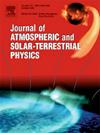Five-years altitude statistics of noctilucent clouds based on multi-site wide-field camera survey
IF 1.8
4区 地球科学
Q3 GEOCHEMISTRY & GEOPHYSICS
Journal of Atmospheric and Solar-Terrestrial Physics
Pub Date : 2025-03-05
DOI:10.1016/j.jastp.2025.106491
引用次数: 0
Abstract
The results of simultaneous measurements of noctilucent clouds (NLC) position in a number of ground-based locations are presented. Observational data of 14 bright NLC events over 5 years is used for building the altitude maps of the cloud fields using the triangulation technique updated for multi-location case. The statistical distribution of NLC altitude and its change during the summer season is considered. Mean NLC altitudes are compared with estimations by colorimetric technique based on the same data and simple radiation transfer model. This can be used to check the model and estimate the accuracy of single-camera technique of NLC altitude measurements. Clouds appear in the altitude range from 79 to 84 km, the average height of NLC is found to be 81.4 km, while the mean brightness-weighted altitude is 0.5 km below this. The brightest clouds are observed near 80 km, where the ice particles can reach the maximal size. Possible effects of the increased height of NLC during the beginning of summer (June) and maximal solar activity (2024) are noted. Results and methods are suggested for the net ground-based survey of noctilucent clouds.
求助全文
约1分钟内获得全文
求助全文
来源期刊

Journal of Atmospheric and Solar-Terrestrial Physics
地学-地球化学与地球物理
CiteScore
4.10
自引率
5.30%
发文量
95
审稿时长
6 months
期刊介绍:
The Journal of Atmospheric and Solar-Terrestrial Physics (JASTP) is an international journal concerned with the inter-disciplinary science of the Earth''s atmospheric and space environment, especially the highly varied and highly variable physical phenomena that occur in this natural laboratory and the processes that couple them.
The journal covers the physical processes operating in the troposphere, stratosphere, mesosphere, thermosphere, ionosphere, magnetosphere, the Sun, interplanetary medium, and heliosphere. Phenomena occurring in other "spheres", solar influences on climate, and supporting laboratory measurements are also considered. The journal deals especially with the coupling between the different regions.
Solar flares, coronal mass ejections, and other energetic events on the Sun create interesting and important perturbations in the near-Earth space environment. The physics of such "space weather" is central to the Journal of Atmospheric and Solar-Terrestrial Physics and the journal welcomes papers that lead in the direction of a predictive understanding of the coupled system. Regarding the upper atmosphere, the subjects of aeronomy, geomagnetism and geoelectricity, auroral phenomena, radio wave propagation, and plasma instabilities, are examples within the broad field of solar-terrestrial physics which emphasise the energy exchange between the solar wind, the magnetospheric and ionospheric plasmas, and the neutral gas. In the lower atmosphere, topics covered range from mesoscale to global scale dynamics, to atmospheric electricity, lightning and its effects, and to anthropogenic changes.
 求助内容:
求助内容: 应助结果提醒方式:
应助结果提醒方式:


